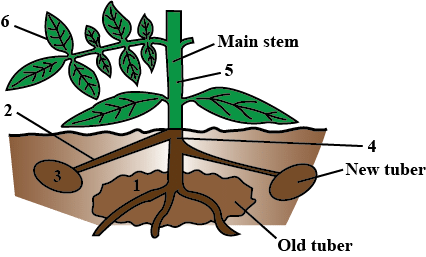Test: Xylem & Phloem Transport (Old NCERT) - JAMB MCQ
10 Questions MCQ Test Biology for JAMB - Test: Xylem & Phloem Transport (Old NCERT)
Water moves up against gravity and even for a tree of 20m height, the tip receives water within two hours. The most important physiological phenomenon which is responsible for the upward movement of water is _______.
Unidirectional flow of water, minerals, some organic nitrogen and hormones occurs through
| 1 Crore+ students have signed up on EduRev. Have you? Download the App |
Which of the following statements is incorrect?
The transpiration-driven ascent of xylem sap depends mainly upon ____ property of water.
The given diagram shows a potato plant forming new tubers.
Which route would be taken by most of the food at this time?

Read the given statements and select the correct options.
Statement 1: Xylem transport is unidirectional.
Statement 2: Phloem transport is bi-directional.
The manufactured food in a green plant moves from the leaves ot other parts through
Organic substances such as sugars are translocated in the phloem. It can be demonstrated by
Mass flow hypothesis was first described by
|
224 videos|175 docs|151 tests
|

















